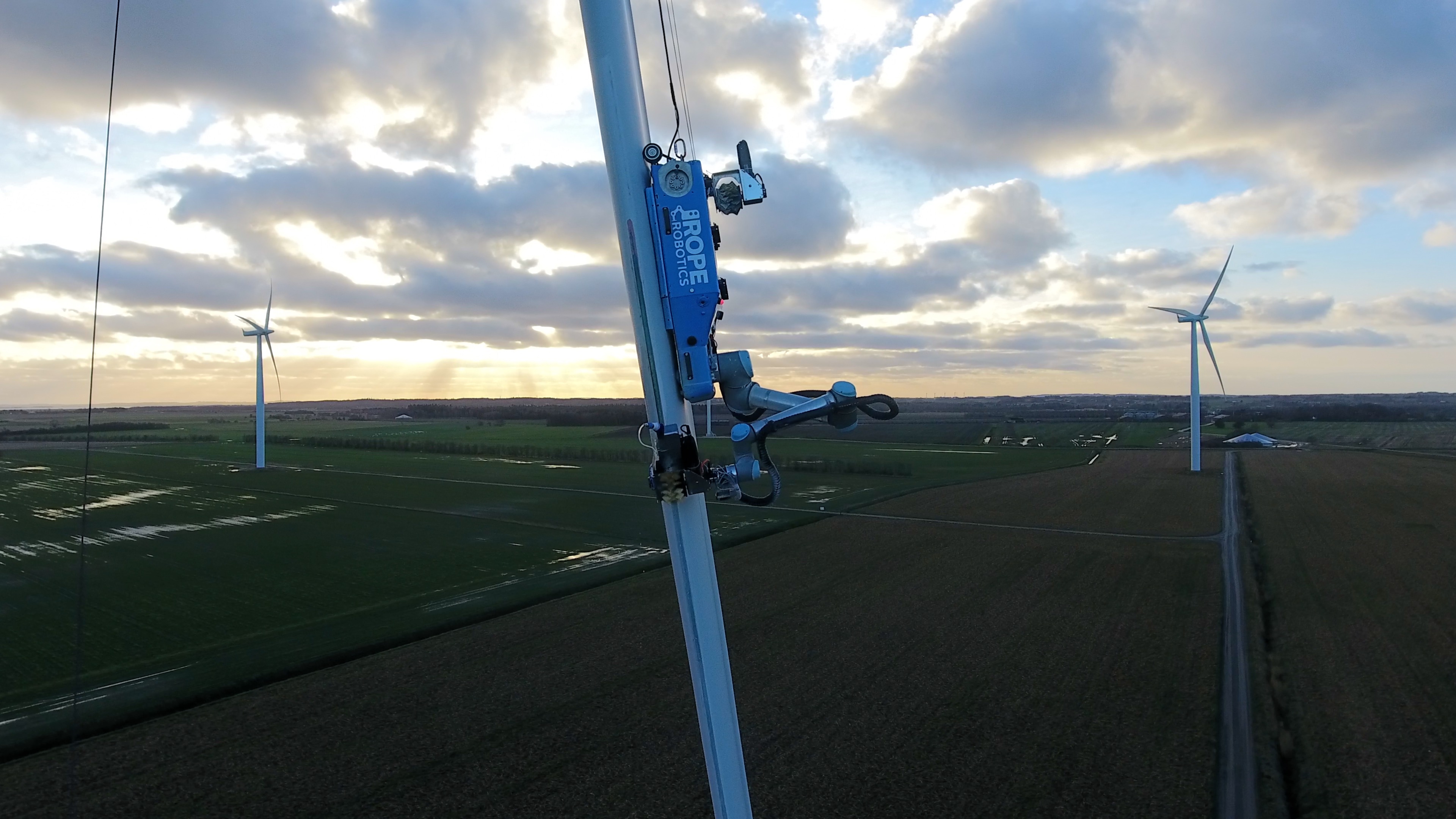
Initial commercial results: return on investment after six months
•Patented robot first to offer practical field repairs; offshore in 2024
•Leading-edge repair demand increasing
•Benefits: four times faster than manual at half the costs;safety for technicians
•Multi-use robot with tools and dexterous arm; remote control
•Breakthrough in application of viscous materials
•Future robots use AI for autonomous tasks
AARHUS, Denmark, 6 February, 2023 – After over18 months in operation, having repaired over 150 rain-damaged onshore wind turbine bladeson three continents, the patented robot from Denmark’s Rope Robotics, the world leader in robotic blade maintenance, has demonstrated return on investment for turbine owners within just six months. Compared to manual alternatives, the robot can repair the blade around four times faster at half the cost.
An increasing problem, rain erosion damage compromises aerodynamic performance of the blade and at worst can lead to blade failure and expensive turbine downtime. The repairs offered by Rope Robotics not only restore turbine power output but are quick, cost-effective and efficient as well as safe for technicians to perform in all but the most inclement weather conditions. Previously, technicians have had to abseil from the nacelle to the blade and work with harmful chemicals, a high-risk work environment that is weather-dependent and costly.
“Rain erosion is an already serious and worsening issue with the longer rotor blades generating tip speeds of over 380 kilometres per hour. Rain drops at that speed act like a hail of bullets that, over time, damage the leading edge of the blade,” explains Martin Huus Bjerge, CEO, Rope Robotics.
Efficient leading-edge repair contributes to life extension of one of the most expensive components on a wind turbine accounting for some 25 to 30 percent of the build cost.
Improved annual energy output (AEP) of 3 percent; offshore testing underway
Rope Robotics’ “BR-8” robot can restore up to 3 percent energy output within less than one day per blade at half the cost of manual solutions. First on the market, Rope Robotics’ nine robots have been in commercial operation for 18 months and have repaired over 150 wind turbine blades in the U.S., Canada, South Africa and Europe.
“Feedback from customers so far confirms our calculations that after six months, the investment in the robot repair service has paid off,” says Martin Huus Bjerge.
“The robot has been well received especially in countries like the U.S. and South Africa where there has been a backlog of repairs. The robot is therefore an additional capacity to the market right now,” he adds.
Applying results from the onshore repairs in countries like Denmark, Sweden and Germany, test repairs on offshore turbines are in progress, in preparation for a commercial launch scheduled at the end of this year.
The core of the system is a robot carrying visual sensors, which operates repair tools using a flexible arm, with technicians monitoring the robot from any location, onsite or remotely.
Robot hoisted by ropes and gripping blade with vacuum system
On site, the 150-kg robot is first attached to ropes that have been anchored in the nacelle before it is hoisted some 100 meters from the ground onto the damaged blade, which has been fixed in a vertical position. A vacuum system allows the robot to attach itself firmly while motors enable movement across the blade. Using its onboard high-resolution camera and laser scanner, the robot inspects the surface, sending images to the remote operator, who diagnoses the damage and initiates the repair process in real time.
Cleaning, sanding and restoring blade
The three-phase repair process starts with sanding the damaged area, applying appropriate speed and force to create a pattern ensuring surface roughness and geometry. A second tool cleans the surface using a brush and alcohol to remove dirt and grease. The patented dosing tool applies the leading-edge protective (LEP) material while the spreader tool, also patented, rebuilds the optimal aerodynamic blade shape, smoothening the material to pre-defined standards.
On-screen remote control and documentation
Controlled remotely on-screen by a technician viewing live images, the robot performs each step with high precision and consistency, thus ensuring quality. All images are recorded and serve as documentation, a global requirement for wind turbine maintenance.
Awarded two patents covering the robot system, the method, the spreading tool and the dosing tool, the robot took five years to develop and was launched in 2021.
“Perhaps surprisingly, the biggest challenge was to develop a functioning spreader and dosing tool that can apply viscous material both accurately and flexibly to fit different blade types. There are so many variables to consider like temperature, humidity and fluid dynamics. Implementing that into a fully functioning robot that is now working on wind farms around the world was an arduous but fulfilling task,” concludes Martin Huus Bjerge.
Extended weather window and prior training
After leading-edge damage has been established, typically by drones, the wind farm or service provider contracts Rope Robotics, who supplies the robot along with technician training and support on site.
The robot has been proven in the field at wind speeds of up to 14 meters per second, relative humidity of up to 80 percent and temperatures from 0 to 40 degrees Celsius.
Using results from the over 150 blade repairs already performed worldwide, Rope Robotics is investing in Artificial Intelligence (AI) to offer autonomous repairs in the future.



